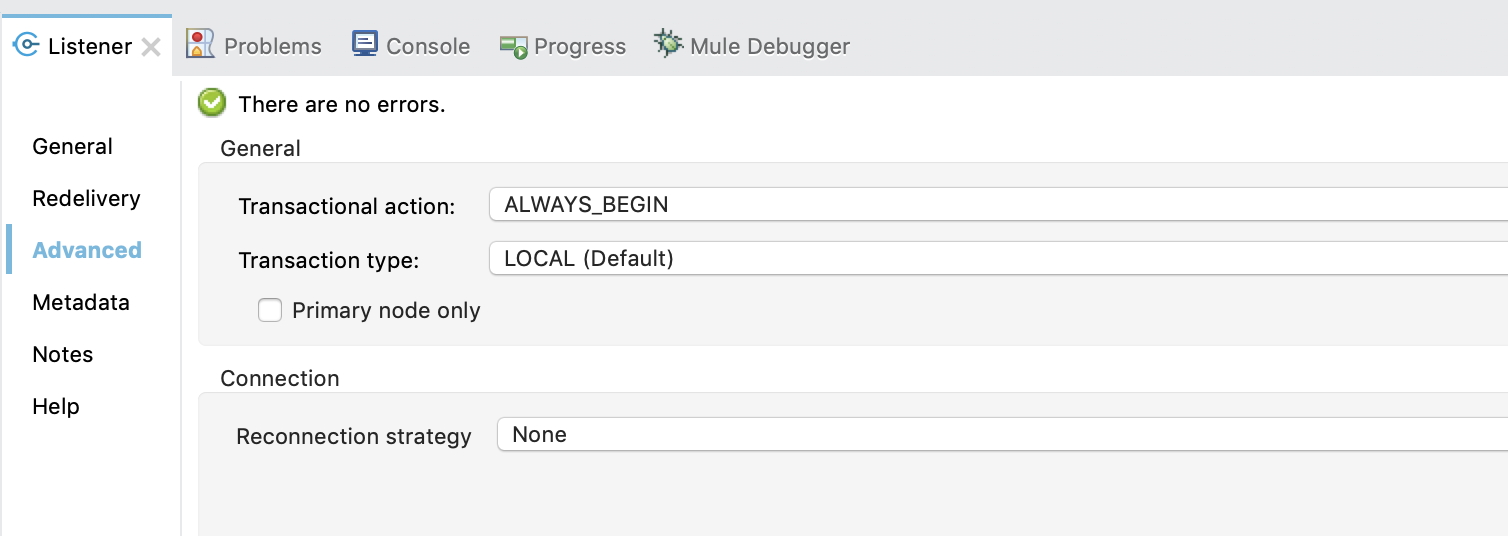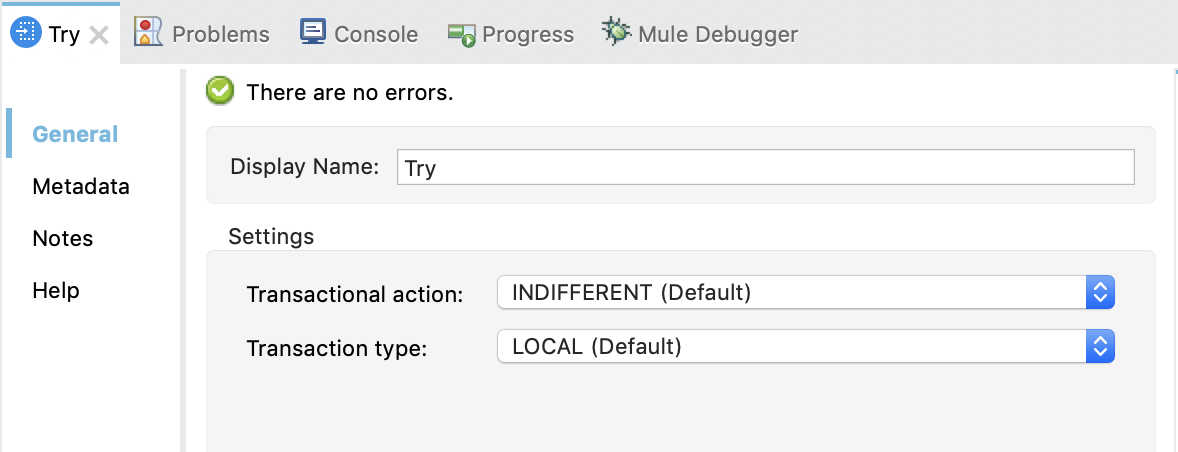Transaction Management
|
Standard Support for Mule 4.1 ended on November 2, 2020, and this version of Mule reached its End of Life on November 2, 2022, when Extended Support ended. Deployments of new applications to CloudHub that use this version of Mule are no longer allowed. Only in-place updates to applications are permitted. MuleSoft recommends that you upgrade to the latest version of Mule 4 that is in Standard Support so that your applications run with the latest fixes and security enhancements. |
Transactions are operations in a Mule app for which the result cannot remain indeterminate. When a series of steps in a flow must succeed or fail as one unit, Mule uses a transaction to demarcate that unit.
For example, you might use a transaction to encapsulate several steps in a flow that result in committing information to a database. In this type of scenario, the commit (or transaction) is either entirely complete and succeeds, or is incomplete and fails. Even if partially complete, the commit fails. When a transaction fails, Mule rolls back the operations within the transaction so that no part results in partial completion.
Implement a Reliability Pattern to design your application so it is capable of reliable messaging, even if the application receives messages from a non-transactional connector.
You can also configure Bitronix to manage transactions in your Mule application.
Transaction Types
Mule supports Single Resource (Local, the default) and Extended Architecture (XA) transaction types (transactionType). The only components that can define the transaction type are message sources (For example, jms:listener and vm:listener) and the Try scope.
The following table describes the characteristics of each transaction type and the requisites for an operation to join the transaction:
| Transaction Type | Characteristics | Requisites to Join the Transaction |
|---|---|---|
|
|
|
|
|
Transactional Actions
A Transactional Action (transactionalAction) defines the type of action that operations take regarding transactions. The following table describes all available transactional actions:
| Action | Behavior | Available in |
|---|---|---|
|
Always start a new transaction when receiving a message. If a Single Resource transaction exists, an error occurs. If an XA transaction exists, a nested transaction is created. |
|
|
Always expect a transaction to be in progress when a message is received. If there is no transaction, an error occurs. |
|
|
If a transaction is already in progress when a message is received, join the transaction if possible. Otherwise, start a new transaction. |
|
|
Join the current transaction if one is available. Otherwise, no transaction is created. |
|
|
Do not treat actions as a transaction. |
|
|
Do not initiate a transaction. |
|
|
Execute outside any existent transaction. |
|
Configuring a Transaction in the Message Source
You can start a transaction from a message source. In this case, the entire flow becomes a transaction. This is useful when working with messaging connectors to prevent the consumption of the message if a problem occurs when processing it, allowing you to retry later (because of the rollback).
To initiate a transaction from a message source, configure its Transaction type and Transactional action:
-
In Anypoint Studio
Open the Listener’s Advanced tab, and set the Transaction type and the Transactional action values:

-
In the Configuration XML
Add the
transactionalActionelement and thetransactionTypeelement (if necessary), and set their values.The XML example below illustrates a
vm:listenermessage source configured to initiate a Single Resource (Local) transaction:<?xml version="1.0" encoding="UTF-8"?> <mule xmlns:http="http://www.mulesoft.org/schema/mule/http" xmlns:vm="http://www.mulesoft.org/schema/mule/vm" xmlns="http://www.mulesoft.org/schema/mule/core" xmlns:doc="http://www.mulesoft.org/schema/mule/documentation" xmlns:xsi="http://www.w3.org/2001/XMLSchema-instance" xsi:schemaLocation="http://www.mulesoft.org/schema/mule/core http://www.mulesoft.org/schema/mule/core/current/mule.xsd http://www.mulesoft.org/schema/mule/vm http://www.mulesoft.org/schema/mule/vm/current/mule-vm.xsd http://www.mulesoft.org/schema/mule/http http://www.mulesoft.org/schema/mule/http/current/mule-http.xsd"> <vm:config name="VM_Config1" > <vm:queues > <vm:queue queueName="input" /> <vm:queue queueName="output" /> </vm:queues> </vm:config> <flow name="source-transactionsFlow"> <vm:listener config-ref="VM_Config1" queueName="input" transactionalAction="ALWAYS_BEGIN"/> <http:request method="GET" url="www.google.com"/> <vm:publish config-ref="VM_Config1" queueName="output"/> </flow> </mule>
Configuring a Transaction in a Try Scope
A Mule flow can also begin with a non-transactional connector (such as HTTP) that requires a transaction within the flow. For example, a Mule flow might accept information from an external Web service, then transform the data before charging a credit card and saving invoice information to a database. In such a situation, you use the Try scope to set up a transaction by wrapping the credit card charge and database commit operations within a transaction to ensure either complete success or complete failure and rollback.
You can configure a transaction in a Try scope component by setting a Transaction type and Transactional action:
-
In Anypoint Studio
Open the Try scope’s General tab, and set the Transaction type and the Transactional action values:

-
In the Configuration XML
Add the
transactionalActionelement and thetransactionTypeelement (if necessary), and set their values.In the following XML example the Try scope demarcates a transaction that includes a Database operation (
db:insert) and a VM operation (vm:publish). Either both will be applied if the entire process succeeds, or none will be applied if an error occurs within the Try scope:<?xml version="1.0" encoding="UTF-8"?> <mule xmlns:vm="http://www.mulesoft.org/schema/mule/vm" xmlns:db="http://www.mulesoft.org/schema/mule/db" xmlns="http://www.mulesoft.org/schema/mule/core" xmlns:doc="http://www.mulesoft.org/schema/mule/documentation" xmlns:xsi="http://www.w3.org/2001/XMLSchema-instance" xsi:schemaLocation="http://www.mulesoft.org/schema/mule/core http://www.mulesoft.org/schema/mule/core/current/mule.xsd http://www.mulesoft.org/schema/mule/db http://www.mulesoft.org/schema/mule/db/current/mule-db.xsd http://www.mulesoft.org/schema/mule/vm http://www.mulesoft.org/schema/mule/vm/current/mule-vm.xsd"> <db:config name="Database_Config"> <db:derby-connection database="myDb" create="true" /> </db:config> <vm:config name="VM_Config"> <vm:queues> <vm:queue queueName="myQueue" /> </vm:queues> </vm:config> <flow name="transactionsFlow"> <try transactionalAction="ALWAYS_BEGIN" transactionType="XA"> <db:insert doc:name="Insert" transactionalAction="ALWAYS_JOIN"> <db:sql> INSERT INTO main_flow_audit (errorType, description) VALUES (:errorType, :description) </db:sql> <db:input-parameters><![CDATA[ #[{ 'errorType' : 'AUTHENTICATION', 'description' : 'invalid authentication credentials', }] ]]></db:input-parameters> </db:insert> <vm:publish config-ref="VM_Config" queueName="myQueue" transactionalAction="ALWAYS_JOIN"/> </try> </flow> </mule>
How Transactions Affect Scopes and Routers
When running in a transactional scope, the entire process must run in the same thread. This can change the way a scope executes, or how a transaction is handled. Below is detailed the behavior of the scopes and routers you must consider when running in a transactional scope:
Scopes
-
Async: When running within a transaction, the Async scope will still run in another thread (remaining asynchronous). However, this means that the entire execution of the processors within this scope is out of the transactional scope. Therefore, any error produced inside an Async scope does not result in a rollback.
-
Until Successful: When running within a transaction, the Until Successful scope blocks the thread. This means that the thread used by this execution cannot be used to process any other request while the Until Successful scope is performing the delay between retries.
-
Batch Processing: Since Batch Processing is designed to work on parallel as the Async scope, and every record is treated transactionally (with internal Batch transactions), the batch execution is not part of the transaction.
Routers
-
Scatter Gather: When running within a transaction, Scatter Gather does not execute in parallel. This means that the second route is executed after the first one is processed, the third after the second one, etc. This does not affect the way this component handles errors.
-
Flow Reference: If the flow (or subflow) being executed is running within a transaction, the execution of the flow (or subflow) referenced by the Flow Reference component continues with the same transaction. If the referenced flow has a message source that begins a transaction (For example a
jms:listenersource withtransactionalAction="ALWAYS_BEGIN"), thetransactionalActionis ignored. The Flow Reference component executes the referenced flow components except for its message source.
Any other router or scope continues with the transaction and its behavior is not modified.
Error Handling
When an error occurs during a transaction, your application must either handle the error and continue or perform a rollback.
There are two types of error handlers, which behave differently when an error occurs during a transaction:
-
On Error Propagate
-
If the
on-error-propagateerror handler is inside theerror-handlerscope corresponding to the component that began the transaction:The transaction is rolled back before executing the processors of the
on-error-propagatescope. This means that the processors inside the error handler do not run within the transaction. -
If the
on-error-propagateerror handler is inside an element that did not start the transaction:The transaction is not rolled back and the processors inside the
on-error-propagateerror handler run within the transaction. Remember that some scopes and routers behave differently when executing within a transaction.
-
-
On Error Continue
The error is handled, the transaction remains active and is able to commit. The processors inside the
on-error-continuerun within the transaction.
Example: Error Occurs in Try Scope
Consider an example in which the message source (jms:listener) starts a transaction, which is continued by the Try scope (transactionalAction is set to default, INDIFFERENT).
When the error occurs, it is handled by the error-handler of the Try scope first. The error is handled by an on-error-propagate error handler, but the transaction is not rolled back because it was not the Try scope that started the transaction. Only the flow error handler can roll back the transaction, because the transaction was initiated at flow level (from its message source).
The jms:publish operation inside the on-error-propagate error handler joins the transaction. The error is then propagated to the flow error-handler, which handles the error with an on-error-continue error handler. The jms:consume operation inside the on-error-continue error handler runs within the transaction. Finally, the transaction is committed.
<flow name="someFlowWithTx">
<jms:listener config-ref="JMS_Config" destination="test.in" transactionalAction="ALWAYS_BEGIN"/>
<!-- Processors -->
<try>
<raise-error type="APP:SOME"/>
<error-handler>
<on-error-propagate>
<jms:publish config-ref="JMS_Config" destination="test.out" transactionalAction="ALWAYS_JOIN"/>
</on-error-propagate>
</error-handler>
</try>
<error-handler>
<on-error-continue>
<jms:consume config-ref="JMS_Config" destination="test.in2" transactionalAction="ALWAYS_JOIN"/>
</on-error-continue>
</error-handler>
</flow>If the on-error-continue error handler is replaced with an on-error-propagate error handler in the previous example, then the transaction is rolled back before the execution of the processors. In this scenario, the configuration is not correct because the jms:consume operation cannot join any transaction.
Example: Error Occurs in a Referenced Flow
The following example behaves the same as the previous one, but instead of having a Try scope it uses a Flow Reference and the error occurs in the referenced flow:
<flow name="someFlowWithTx">
<jms:listener config-ref="JMS_Config" destination="test.in" transactionalAction="ALWAYS_BEGIN"/>
<!-- Processors -->
<flow-ref name="someFlowContinuesTx"/>
<error-handler>
<on-error-continue>
<jms:consume config-ref="JMS_Config" destination="test.in2" transactionalAction="ALWAYS_JOIN"/>
</on-error-continue>
</error-handler>
</flow>
<flow name="someFlowContinuesTx">
<raise-error type="APP:SOME"/>
<error-handler>
<on-error-propagate>
<jms:publish config-ref="JMS_Config" destination="test.out" transactionalAction="ALWAYS_JOIN"/>
</on-error-propagate>
</error-handler>
</flow>Because the someFlowContinuesTx flow did not initiate the transaction, its error handler does not roll back the transaction.
Example: Comparing Error Handlers
This example shows the differences between the on-error-continue error handler and the on-error-propagate error handler:
<flow name="flow1">
<jms:listener config-ref="JMS_Config" destination="test.in" transactionalAction="ALWAYS_BEGIN"/>
<raise-error type="APP:SOME"/>
<error-handler>
<on-error-continue>
<try transactionalAction="ALWAYS_BEGIN">
<logger message="hello"/>
</try>
</on-error-continue>
</error-handler>
</flow>
<flow name="flow2">
<jms:listener config-ref="JMS_Config" destination="test.in" transactionalAction="ALWAYS_BEGIN"/>
<raise-error type="APP:SOME"/>
<error-handler>
<on-error-propagate>
<try transactionalAction="ALWAYS_BEGIN">
<logger message="hello"/>
</try>
</on-error-propagate>
</error-handler>
</flow>In flow1, the on-error-continue error handler keeps the transaction active, but the Try scope inside it tries to initiate a new transaction. The configuration is not valid and results in an error.
In flow2, the on-error-propagate error handler rolls back the transaction, the processors inside the on-error-propagate error handler are executed, and a new transaction is created. This configuration is correct.



